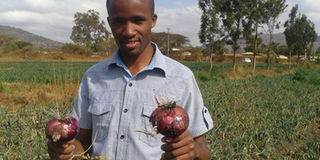All on growing onions, from the soil to market

Machakos onions farmer, Ian Mutisya displays bulb onions that he cultivates. After harvesting and curing, it is recommended to pack the bulbs in open ventilated boxes/nets and store them in a cool dry environment, ready for the market. FILE PHOTO | NATION MEDIA GROUP
What you need to know:
- Adequate soil moisture is required throughout the growing season for optimum yields. Bulb onions require soils rich in organic matter. Sandy loams are most suitable.
- Weeding should be done regularly to remove weeds within and between rows.
- Irrigation is only done when the crop is grown under insufficient rainfall.
- Curing involves removal of the tops and then covering the bulbs to protect them from excessive heat from the sun or any form of moisture.
The numerous questions we receive on onion farming attest to the fact that interest in the crop is growing.
While most of those seeking information are beginners, a good number are practising farmers. In this article, we break down all that you need to know on farming the crops successfully.
Ecological requirements
Highest yields and best quality bulbs are obtained at >1,000m above sea level, although reasonable crop may be realised at lower altitudes. Bulbs form at relatively high temperatures.
Vegetative growth best occurs at 18-250C. At temperatures less than 150C, bulbs do not form. At >250C, bulbs assume maturity before they reach market size resulting in low yields.
Flowers rarely form in regions of high temperatures because a cool period is necessary for initiation of flowering (<70C). Seedlings are fairly tolerant to high rainfall, which towards crop maturity may result in increased incidences of thick necks.
Adequate soil moisture is required throughout the growing season for optimum yields. Bulb onions require soils rich in organic matter. Sandy loams are most suitable.
Ideal soil pH is 5.8-6.8 but the crop may grow on acidic soils. It is recommended to maintain good levels of phosphorous and potassium in the soil. Phosphorous is important for root growth while potassium is important for bulbing.
Propagation and planting
Onions are propagated sexually by use of seeds or asexually through sets.
Where seeds are used, they may be established directly in the main field or started in a nursery and later transplanted when seedlings are pencil thick to the main field at a spacing of 30 by 10cm.
Where established directly, thinning has to be done when the plant establishes. Transplanting eliminates the need for thinning but the method is very tedious.
Seed rate
Plant 350 g/ha. The use of sets allows for production of earlier green onion. Sets are planted at 2.5 – 5cm apart for green onions or 8-10cm apart for bulbs.
In this case, machines can be used for large field planting.
Fertiliser
Around 20 tonne/ha, well-decomposed organic matter before planting. Apply 200kg/ha DSP at transplanting.
This is very important because onions are very sensitive to phosphorus deficiency.
Apply 300kg/ha CAN when plants start growing after transplanting to encourage early vegetative growth, which may be applied in two splits.
Irrigation
Only done when the crop is grown under insufficient rainfall. If practised, irrigation should be stopped 2-3 weeks before harvesting to give the bulbs time to cure.
Weeding
It should be done regularly to remove weeds within and between rows. As bulbs form, avoid earthing up otherwise moist conditions may encourage rotting or development of thick necks.
Instead of earthing up, dearth to encourage expansion of bulbs.
Harvesting
Bulbs mature from 140 days depending on cultivar and weather conditions. Yields of up to 10 tonne/ha are possible. Bend the necks as soon as tips of leaves begin to turn yellow or when around 10 per cent of the crop is dry and leave the crop to dry for 14-21 days before harvesting (digging bulbs up).
This treatment makes bulbs to have a smooth closure and minimises thick necks. After harvesting, bulbs should be cured before storage.
Curing involves removal of the tops and then covering the bulbs to protect them from excessive heat from the sun or any form of moisture.
Tops are cut off by hand, knife or shears leaving 1-2.5cm of dried tops attached to the bulb, otherwise the bulb will decay.
Very dry conditions during curing will dehydrate the bulbs while very humid environment encourages fungal growth.
Cool slightly humid conditions are ideal for curing. While in this environment, roots should be cut to 1cm and the bulbs left in for 2-3 weeks depending on the weather.
The cool environment will encourage toughening of the scaly leaves to be able to protect the inner flesh.
Field curing may also be done where after bending the tops; the bulbs are uprooted and spread on the ground so long as there is no excess sun.
After curing, it is recommended to pack the bulbs in open ventilated boxes/nets and store them in a cool dry environment, ready for the market.
The writer works in the Department of Crops, Horticulture and Soils, Egerton University.




